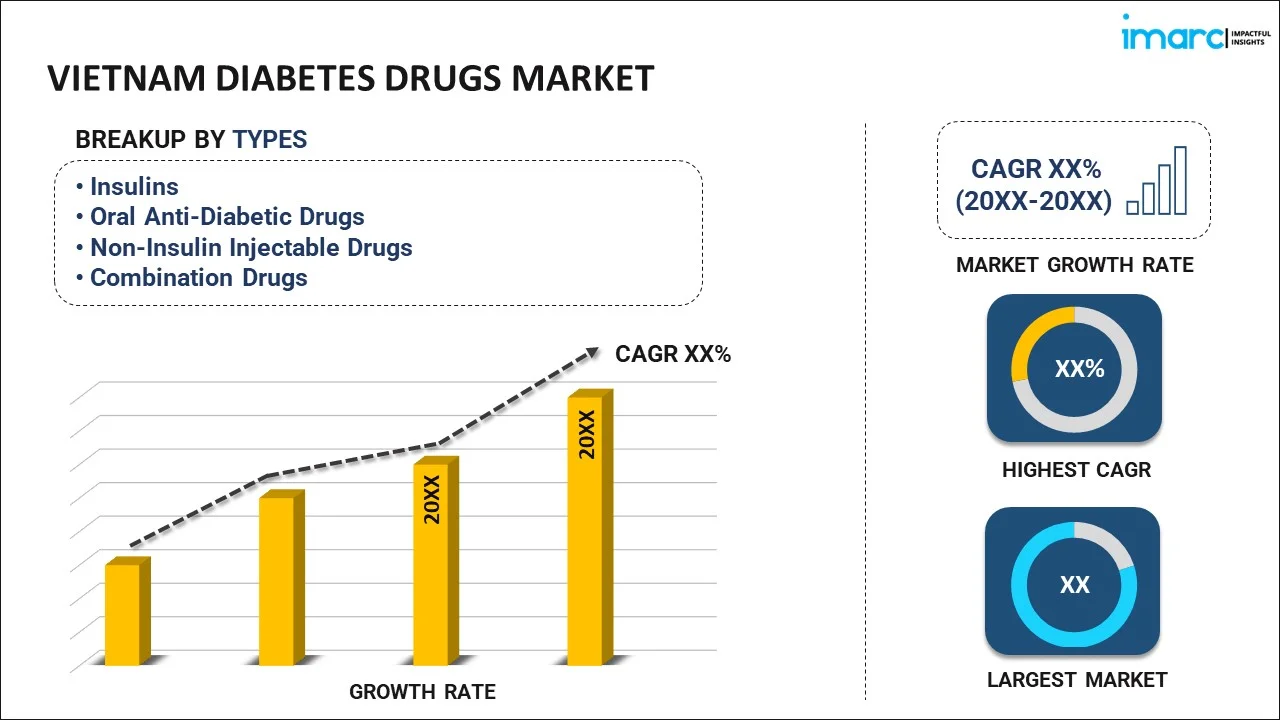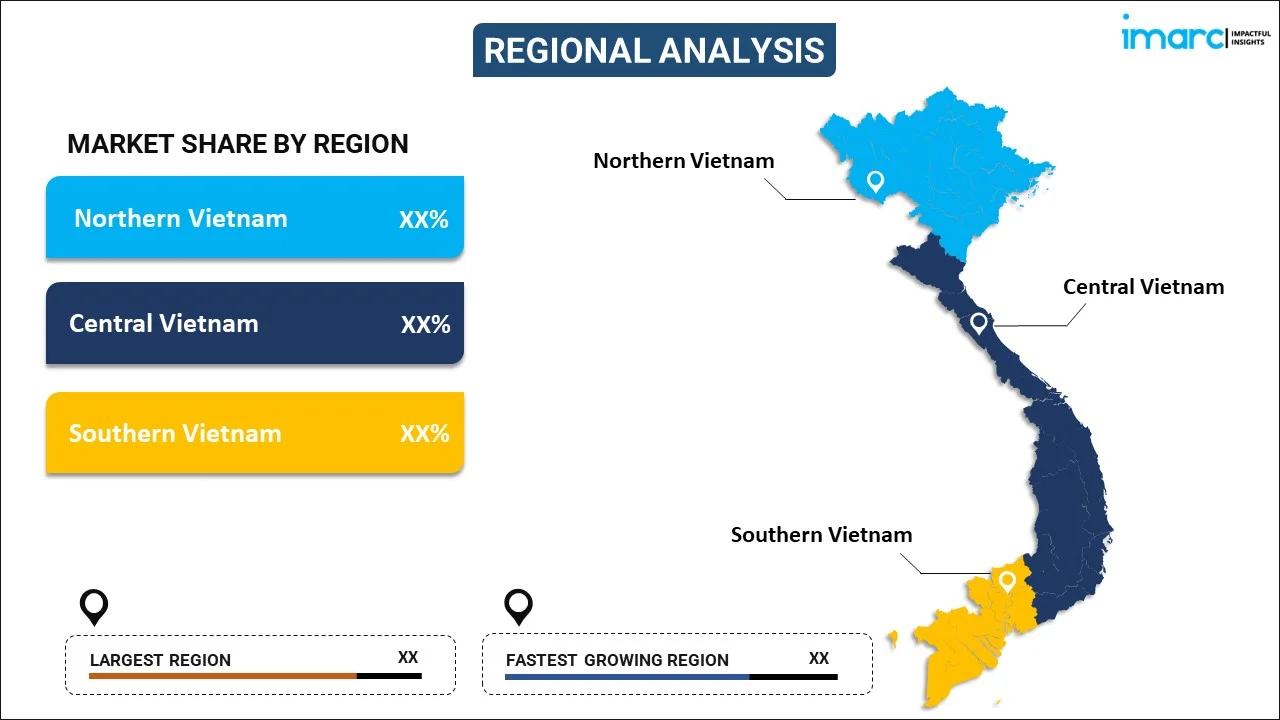
Vietnam Diabetes Drugs Market Report by Type (Insulins, Oral Anti-Diabetic Drugs, Non-Insulin Injectable Drugs, Combination Drugs), Distribution Channel (Online Pharmacies, Hospital Pharmacies, Retail Pharmacies), and Region 2025-2033
Market Overview:
Vietnam diabetes drugs market size is projected to exhibit a growth rate (CAGR) of 6.16% during 2025-2033. The growing elderly population, rising prevalence of diabetes, better access to medical treatments, innovations in drug formulations and delivery systems, and growing government initiatives in the healthcare sector represent some of the key factors driving the market.
|
Report Attribute
|
Key Statistics
|
|---|---|
|
Base Year
|
2024 |
|
Forecast Years
|
2025-2033
|
|
Historical Years
|
2019-2024
|
| Market Growth Rate (2025-2033) | 6.16% |
Diabetes drugs are pharmaceuticals specifically designed to manage and treat diabetes, a chronic medical condition characterized by elevated blood sugar levels. There are two primary types of diabetes Type 1 and Type 2, each requiring different medication protocols for effective management. In Type 1 diabetes, the body does not produce insulin, the hormone responsible for facilitating the uptake of glucose into cells for energy. Patients with Type 1 diabetes typically rely on regular insulin injections to maintain blood sugar levels within a healthy range. Type 2 diabetes it occurs when the body cannot use insulin efficiently, leading to insulin resistance. For treating this form, a variety of medications exist, which reduce glucose production in the liver, stimulate increased insulin production, or make insulin more effective. Some drugs combine multiple active ingredients to offer comprehensive control over blood sugar levels. Both forms of diabetes may also necessitate lifestyle changes, including diet modifications and regular exercise, in addition to pharmacological interventions.
Vietnam Diabetes Drugs Market Trends:
An increase in the number of diabetes cases represents one of the significant factors driving the growth of the diabetes drugs market across Vietnam. This is primarily attributed to lifestyle changes, widespread adoption of Western diets, and lack of physical activity, which are contributing to a rise in diabetes rates. The aging population in the country is more susceptible to chronic conditions like diabetes. This demographic trend necessitates a robust healthcare infrastructure, which is fueling the market. The market is also driven by the evolving healthcare system, along with the economic development of the country, which is providing better access to medical treatments. Enhanced healthcare facilities and services elevate the potential for diabetes drug sales. The Government of Vietnam is supporting various programs aimed at raising awareness and improving diabetes management, which is fueling the market growth. Public awareness campaigns about diabetes are encouraging early diagnosis and are driving the demand for diabetes drugs. Innovations in drug formulations and delivery systems, like insulin pens and pumps, are also propelling the market. These advancements offer more effective and convenient treatment options to patients. Moreover, rapid urbanization often leads to sedentary lifestyles and increased stress levels, both of which are risk factors for developing diabetes. This creates a domino effect, which is driving the demand for diabetes medications. The presence of multinational pharmaceutical companies in Vietnam is making a wider range of diabetes drugs available to consumers. These companies often bring in high-quality medications that comply with international standards, which creates a positive outlook for the market across the country.
Vietnam Diabetes Drugs Market Segmentation:
IMARC Group provides an analysis of the key trends in each segment of the market, along with forecasts at the country level for 2025-2033. Our report has categorized the market based on type and distribution channel.
Type Insights:

- Insulins
- Basal or Long Acting Insulins
- Bolus or Fast Acting Insulins
- Traditional Human Insulins
- Biosimilar Insulins
- Oral Anti-Diabetic Drugs
- Biguanides
- Alpha-Glucosidase Inhibitors
- Dopamine D2 Receptor Agonist
- SGLT-2 Inhibitors
- DPP-4 Inhibitors
- Sulfonylureas
- Meglitinides
- Non-Insulin Injectable Drugs
- GLP-1 Receptor Agonists
- Amylin Analogue
- Combination Drugs
- Insulin Combinations
- Oral Combinations
The report has provided a detailed breakup and analysis of the market based on the type. This includes insulins (basal or long acting insulins, bolus or fast acting insulins, traditional human insulins, and biosimilar insulins), oral anti-diabetic drugs (biguanides, alpha-glucosidase inhibitors, dopamine D2 receptor agonist, SGLT-2 inhibitors, DPP-4 inhibitors, sulfonylureas, and meglitinides), non-insulin injectable drugs (GLP-1 receptor agonists and amylin analogue), and combination drugs (insulin combinations and oral combinations).
Distribution Channel Insights:
- Online Pharmacies
- Hospital Pharmacies
- Retail Pharmacies
A detailed breakup and analysis of the market based on the distribution channel have also been provided in the report. This includes online pharmacies, hospital pharmacies, and retail pharmacies.
Regional Insights:

- Northern Vietnam
- Central Vietnam
- Southern Vietnam
The report has also provided a comprehensive analysis of all the major regional markets, which include Northern Vietnam, Central Vietnam, and Southern Vietnam.
Competitive Landscape:
The market research report has also provided a comprehensive analysis of the competitive landscape in the market. Competitive analysis such as market structure, key player positioning, top winning strategies, competitive dashboard, and company evaluation quadrant has been covered in the report. Also, detailed profiles of all major companies have been provided.
Vietnam Diabetes Drugs Market Report Coverage:
| Report Features | Details |
|---|---|
| Base Year of the Analysis | 2024 |
| Historical Period | 2019-2024 |
| Forecast Period | 2025-2033 |
| Units | Million USD |
| Scope of the Report | Exploration of Historical and Forecast Trends, Industry Catalysts and Challenges, Segment-Wise Historical and Predictive Market Assessment:
|
| Types Covered |
|
| Distribution Channels Covered | Online Pharmacies, Hospital Pharmacies Retail Pharmacies |
| Regions Covered | Northern Vietnam, Central Vietnam, Southern Vietnam |
| Customization Scope | 10% Free Customization |
| Post-Sale Analyst Support | 10-12 Weeks |
| Delivery Format | PDF and Excel through Email (We can also provide the editable version of the report in PPT/Word format on special request) |
Key Questions Answered in This Report:
- How has the Vietnam diabetes drugs market performed so far and how will it perform in the coming years?
- What has been the impact of COVID-19 on the Vietnam diabetes drugs market?
- What is the breakup of the Vietnam diabetes drugs market on the basis of type?
- What is the breakup of the Vietnam diabetes drugs market on the basis of distribution channel?
- What are the various stages in the value chain of the Vietnam diabetes drugs market?
- What are the key driving factors and challenges in the Vietnam diabetes drugs?
- What is the structure of the Vietnam diabetes drugs market and who are the key players?
- What is the degree of competition in the Vietnam diabetes drugs market?
Key Benefits for Stakeholders:
- IMARC’s industry report offers a comprehensive quantitative analysis of various market segments, historical and current market trends, market forecasts, and dynamics of the Vietnam diabetes drugs market from 2019-2033.
- The research report provides the latest information on the market drivers, challenges, and opportunities in the Vietnam diabetes drugs market.
- Porter's five forces analysis assist stakeholders in assessing the impact of new entrants, competitive rivalry, supplier power, buyer power, and the threat of substitution. It helps stakeholders to analyze the level of competition within the Vietnam diabetes drugs industry and its attractiveness.
- Competitive landscape allows stakeholders to understand their competitive environment and provides an insight into the current positions of key players in the market.
Need more help?
- Speak to our experienced analysts for insights on the current market scenarios.
- Include additional segments and countries to customize the report as per your requirement.
- Gain an unparalleled competitive advantage in your domain by understanding how to utilize the report and positively impacting your operations and revenue.
- For further assistance, please connect with our analysts.
 Inquire Before Buying
Inquire Before Buying
 Speak to an Analyst
Speak to an Analyst
 Request Brochure
Request Brochure
 Request Customization
Request Customization




.webp)




.webp)












